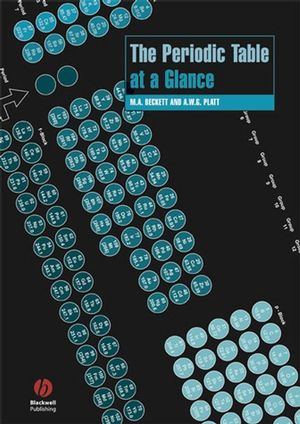The Periodic Table at a GlanceISBN: 978-1-4051-3299-2
Paperback
120 pages
August 2006, Wiley-Blackwell
 This is a Print-on-Demand title. It will be printed specifically to fill your order. Please allow an additional 15-20 days delivery time. The book is not returnable.
|
||||||
1.1 Atomic Structure (I): introduction, electronic properties and wavefunctions.
1.2 Atomic Structure (II): quantum numbers, core and valence orbitals.
1.3 The Periodic Table: overview, atomic masses, the Periodic Table, historical perspective.
1.4 Periodic Properties: atomic, covalent and ionic radii, ionization energies, electron affinities, and electronegativities.
1.5 Redox Processes (I): standard reduction potentials, Latimer diagrams.
1.6 Redox Processes (II): Free Energy Oxidation STate (FROST) diagrams, construction of FROST diagrams, interpreting the FROST diagram.
2. Molecular Structures And Solid-State Giant Structures.
2.1 Covalent Interactions Between Atoms: overview, covalent bonding, Linear combination of atomic orbitals (LCAO), hybridization, polarity of covalent bonds.
2.2 Shapes Of Molecules: Valence-Shell Electron-Pair Repulsion (VSEPR).
2.3 Structure and Bonding in Metals: structures, bonding, properties.
2.4 Ionic and Covalent Solid-State Giant Structures: ionic bonding, simple ionic crystals, cation/anion radius ratio rule, ion polarization, covalent giant structure.
3. s-Block Elements – Main Group Elements (Groups 1,2).
3.1 Group 1 Elements – The Alkali Metals (Li, Na, K, Rb, Cs, Fr): elements, reactivity of the elements, compounds, co-ordination complexes, flame test colours.
3.2 Group 2 Elements – The Alkaline Earths (Be, Mg, Ca, Sr, Ba, Ra): elements, reactivity of the elements, compounds, co-ordination complexes, flame test colours.
3.3 Some Industrial Processes Involving s-Block Elements: production and uses of salt, manufacture of caustic soda and the chloralkali industry, extraction of Na, soda ash, extraction of Mg.
.
4. p-Block Elements – Main Group Elements (Groups 13-18).
4.1 General Overview Of p-Block Elements (I): introduction, electronic configurations, ionization energies, bonding.
4.2 General Overview Of p-Block elements (II): multiple bonds, molecular geometries.
4.3 Group 13 elements (B, Al, Ga, In, Tl): overview, halides, borates and aquo ions, co-ordination chemistry.
4.4 Borazene And The Boron Hydrides: borazene, boron hydrides.
4.5 Group 14 Elements (C, Si, Ge, Sn, Pb): overview, hydrides, multiple bonds, halides, oxides.
4.6 Silicate And Siloxane Chemistry: water glass solutions, solid-state silicate anions, zeolite chemistry, siloxanes.
4.7 Group 15 Elements - The Pnicogens (N, P, As, Sb, Bi): hydrides, halides, oxides, oxyanions, polyphosphazenes.
4.8 Group 16 Elements – The Chalcogens (O, S, Se, Te, Po): oxidation states, hydrides, halides, Lewis acid/Lewis base behaviour.
4.9 Sulphur And Its Compounds (I): minerals and production, allotropes, hydrides and sulphide anions, oxides.
4.10 Sulphur And Its Compounds(II): oxyanions and related compounds, redox chemistry, sulphur-nitrogen chemistry.
4.11 Group 17 Elements –The Halogens (F, Cl, Br, I, At): overview, oxidation states, interhalogen compounds, polyhalides, donor properties of halide anions.
4.12 Group 18 Elements – The ‘Inert’ Gases (He, Ne, Ar, Kr, Xe, Rn): introduction, xenon fluorides, xenon oxygen compounds, compounds with bonds between xenon and other elements, krypton compounds, compounds of radon and argon.
4.13 Some Industrial Processes Involving p-Block Elements (I): Al production, alkene polymerization, bromine.
4.14 Some Industrial Processes Involving p-Block Elements (II): ammonia, nitric acid.
5. Hydrogen.
5.1 Hydrogen – The First Element: occurrence, atomic structure, physical properties of the element, H2 as an industrial chemical, position in the Periodic Table.
5.2 Hydrogen - Chemical Properties: introduction, saline hydrides, covalent hydrides, hydrogen bonds, Bronsted acidity and H+, metallic hydrides.
.
6. d-Block Elements – Transition metals (Groups 3-12).
6.1 Electronic Configurations And General Reactivity: characteristic properties of the d-block elements, electronic configurations, physical properties and general reactivity.
6.2 An Overview Of Chemical And Physical Properties Of The d-Block Elements: co-ordination compounds (formation of complexes), coloured compounds, paramagnetism, catalysis by d-block metals.
6.2 Variable Oxidation States: First transition (3d) series, Group 5 - oxidation states of V, Group 6 - oxidation states of Cr, Group 7 - oxidation states of Mn, oxidation states of the second (4d) and third (5d) transition series.
6.4 Co-ordination Compounds (I): ligands and denticity, co-ordination numbers and co-ordination geometries, the chelate effect.
6.5 Co-ordination Compounds (II): kinetically inert and labile complexes, stepwise and overall stability constants, Irving Williams series for M2+, the effect of metal charge on stability constants, substitution in square-planar Pt(II) complexes.
6.6 Isomerism In Co-ordination Compounds: isomerism, geometrical isomerism, optical isomerism, ionization isomerism, linkage isomerism, co-ordination isomerism.
6.7 Reactions Of Transition Metal Aquo Ions: solution structure of aquo ions, reactivity of aquo ions (redox, acidity, substitution).
6.8 Crystal Field And Ligand field Theory: introduction, octahedral, square-planar, tetrahedral complexes, Jahn-Teller effect.
6.9 Ligand Field Theory And Electronic Spectra (Colours) Of Transition Metal Complexes: colours of transition metal complexes, factors which effect the magnitude of D.
6.10 Ligand Field Theory And Magnetic Properties: overview, magnetic susceptibilty, high spin/low spin complexes, ferromagnetism.
6.11 Metal Carbonyl Chemistry: organometallic compounds, the 18- rule, structures of binary metal carbonyls, substitution mechanisms.
6.12 d-Block Elements And Industrial Chemistry: production of Fe and steel, production of TiO2, purification of Ni, homogeneous catalysis, heterogeneous catalysis.
.
7. f-Block Elements – Lanthanides and Actinides.
7.1 The 4f Elements – The Lanthanides or Rare Earths: introduction, electronic configuration, lanthanide contraction, oxidation states (+3, +2 and +4), typical chemistry.
7.2 The 5f Elements - The Actinides: occurrence, electronic configuration, typical chemistry.
7.3 Some Applications Of The f-Block Elements: lanthanides (medical imaging, catalytic converters), actinides (nuclear fuels, smoke detectors).



